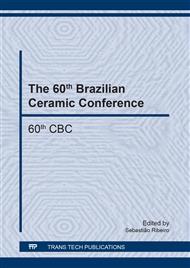p.180
p.185
p.191
p.196
p.202
p.207
p.212
p.218
p.224
Cadmium Adsorption Kinetic Study Using Natural Brasgel Clay the Adsorbent
Abstract:
Heavy industrial activities result in contamination of waste water with many heavy metals, including cadmium, nickel, lead, mercury. Within this context becomes a growing concern of the population and environmental agencies regarding water contamination by heavy metals from industrial effluents. Because of this problem, this paper aims to study and evaluate the main properties of natural Brasgel clay in order to remove cadmium from synthetic effluents, analyzing its kinetic adsorption and its isothermal balance. Once clays exhibit good cation exchange capacity, selectivity and regenerability and for this reason has aroused interest in the use as an adsorbent. As finite bath testing we found that the Brasgel clay, removed approximately 90% of cadmium. The Langmuir model presented best fit to the experimental data, adequately describing the dynamics of adsorption. Kinetic tests indicated that the cadmium removal process by natural Brasgel clay apply the mechanism of the pseudo-second-order rate model, a time of 20 minutes and required to reach equilibrium. Thus, the results indicated that Brasgel clay can be used as an adsorbent for the removal of cadmium from contaminated effluent.
Info:
Periodical:
Pages:
202-206
Citation:
Online since:
January 2018
Keywords:
Price:
Сopyright:
© 2018 Trans Tech Publications Ltd. All Rights Reserved
Share:
Citation:


